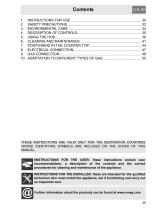
36
Instructions for the installer
9. GAS CONNECTION
Before installation, make sure that the local distribution conditions (nature
and pressure of the gas) and the state of regulation of the appliance are
compatible.
Connection to the gas supply network can be made using a rigid copper
hose or a flexible steel hose with a continuous wall and in compliance
with the guidelines established by the standard UNI-CIG 7129.
Once the operation is complete, check the hose fittings for leaks using a
soapy solution; never use a flame. The cooker hob is preset for natural
gas G20 (2H) at a pressure of 20 mbar.
For supplying it with other types of gas, see chapter "10. ADAPTATION TO
DIFFERENT TYPES OF GAS".
The gas inlet connection is threaded ½” external gas (ISO 228-1).
Connection with rigid copper
hose: The connection to the gas
supply network must be carried out
in such a way that it does not cause
stresses of any type on the
appliance. The connection can be
made using the adapter unit D with
double cone, always inserting the
supplied gasket C in between.
Connection with flexible steel
hose: Use only continuous wall
stainless steel hoses that comply
with standard UNI-CIG 9891, making
sure to always insert the supplied
gasket C between the connection A
and the flexible hose B.
Installation with the flexible hose must be carried out so that the length of
the piping does not exceed 2 metres fully extended; make sure that the
hoses do not come into contact with moving parts and that they are not
crushed in any way.
9.1 Connection to liquid gas
Use a pressure regulator and make the connection on the gas cylinder
following the guidelines established by the regulations in force.
Make sure that the supply pressure complies with the values indicated in
the table at point "10.2 Burner and nozzle characteristics table".



















